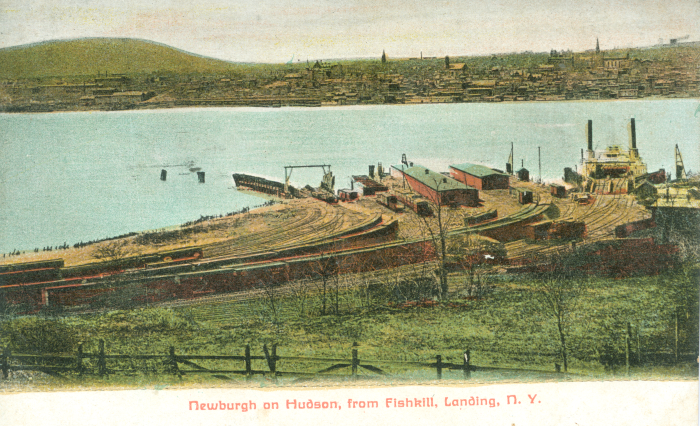Diane Lapis, president of the Beacon Historical Society, and her husband, Peter, own hundreds of local postcards. We asked them to select a few of their favorite city landmarks that are no more. Their comments appear with each image, based on research gleaned from newsletters by the society’s late president, Bob Murphy, that are collected in a new book, Beacon’s Memory Keeper and Storyteller: Robert J. Murphy (beaconhistorical.org).
Highland Hospital
In 1871, Gen. Joseph Howland — a Union Army officer, philanthropist and politician — purchased a home on Washington Street (now Russell Avenue) and gifted it to the city as a hospital. By 1900, it was deemed inadequate and a new hospital was built on Verplanck Avenue. The building was razed in 1960 and a group of townhouses now stand in its place.

Hotel, Casino and Power Station
The Mount Beacon Incline and a casino welcomed 60,000 guests during its first season in 1902. The Beaconcrest Hotel was built six years later. A fire destroyed the casino and hotel in 1927 and the power station, cars and tracks in 1981 and 1983.
![]()
![]()
Long Dock Railroad Terminal
The terminal has worn many hats since 1880: a rail terminal and docking area for the ferry William T. Hart; a link in the New Haven Railroad system; a pig-iron transfer station; a site to store fuel and later salt; and a junkyard. Today it is the home of Long Dock Park.

Nitgedaiget
Located on Route 9D in Dutchess Junction, Nitgedaiget was a vacation resort for Jewish progressive liberals and Communist sympathizers from 1922 to the early 1950s. The complex included a four-story hotel, dining hall, casino/dance hall, business office, pool, sports facilities, bungalows and tents, and could handle 1,000 people a day. Originally a 250-acre property, it is now part of the Hudson Highlands State Park, although remains of its pool can be seen off Notch Trail.

Holland Hotel
Built in 1894, this 50-room brick building with bluestone trim was the most distinctive on Main Street and considered the best hotel in Fishkill Landing and Matteawan (which later joined to become Beacon). It was razed in 1972 and the site is now occupied by Dutchess County offices and a parking lot.


Hat Factories
Beacon was the largest hat manufacturer in New York and second in the country only to Danbury. For nearly a century from 1864, the factories employed thousands of workers who made hundreds of thousands of hats. The heyday was 1920 to 1940. The majority of the factories have been razed or are in ruins but a few have been redeveloped as condos.

Tioronda Bridge
The stone remains of the railroad bridge can be seen going north at Madam Brett Trail Park near South Avenue near the old Tioronda Chapel on the Howland Estate. The trestle was built in the late 1860s by the Dutchess and Columbia Railroad and crossed at Sucker Falls. It connected the railroad spur line at Wiccopee Junction located just below the New York Rubber Co. to its terminal at Dutchess Junction. After the Dutchess Junction terminal closed, the trestle went into disuse and was torn down in 1920.

New York Central Station and Ferry House
The Newburgh-Beacon ferry ran for 220 years — one of the longest running in American history. The most recent terminal was built in 1914 and closed in 1963 with the opening of the Newburgh-Beacon Bridge. It was razed in 1968. The New York Central Railroad built a brick station house in 1915 that was destroyed by fire in 1975. Nothing remains of the plaza.

Fishkill Union Free School No. 8
Opened in 1891 with 12 classrooms and a huge assembly room, the school had more than 400 students in its primary, grammar and other academic departments. The building was destroyed by fire in January 1928 and, within a year, replaced by the current South Avenue School.

Mount Beacon Cottages
A seasonal community of 20 families lived atop the mountain during the heyday of the hotel and incline from about 1900 to 1920. Trolley cars delivered the guests and all their needs to enjoy the cool air. Today, only one cottage remains, in ruins, and can be seen along Howard’s Path.
![]()

Very nice. Thank you, sir.
I’d like to offer a correction and some additional information about the Highland Hospital and the Sargent Industrial School.
The first hospital was a house on Russell Avenue in Matteawan, which was purchased by Gen. Joseph Howland and donated to the village. When the hospital was moved, the original became a family home. My parents bought it in 1950 and I now own it.
The second hospital, shown in the postcard above, was located on Verplanck Avenue. It was replaced in 1960 by a building on Delevan Avenue. You stated that the Verplanck building was razed in 1960, but it actually remained standing (and vacant) into the 1970s, when it was replaced with townhouses.
The Delevan hospital operated for years before being purchased by St. Francis Hospital, which made it a satellite campus with limited services. When St. Francis closed, the Beacon building was sold and renovated, and is now senior housing.
The Sargent Industrial School also started out in a Russell Avenue house, located across the street from the hospital. When the school outgrew the first house, it moved to Schenck Avenue, around the corner from the hospital. In her will, Mrs. Sargent required that the school close upon her death. The building was sold to the hospital as housing for its nurses.